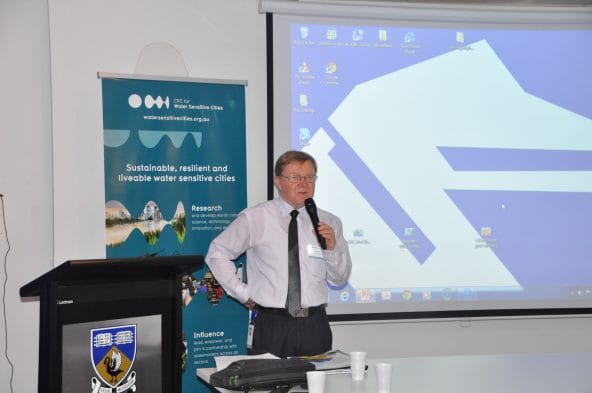Regional Advisory Panels discuss unique local challenges
From the tropical north, through our arid centre, and to the temperate south, Australia is a continent of hugely varying climates, conditions, and seasons. Throw in rapid population growth and the complex number of stakeholders required for planning, urban development, and service delivery, and it’s clear our major capitals face unique challenges when it comes to managing water.
In 2013, in an effort to meet these challenges, the CRC for Water Sensitive Cities (CRCWSC) introduced its first Regional Advisory Panel (RAP) in Perth. Comprising a mix of CRCWSC participant organisations and other water industry professionals – handpicked by the RAP Chair to play a critical role in implementing water-sensitivity outcomes – the idea was to get key industry figures talking and collaborating.
RAPs now also operate in Adelaide, Brisbane, Melbourne, and Sydney, providing an important forum for the CRCWSC to engage local participants and stakeholders: not only to find out if our activities have been meeting their needs but to help translate CRCWSC research outputs into useful, meaningful, and relevant tools and products that are easy to access and apply in the field. Perhaps even more importantly, they collectively influence high level decision-making and guide how the region can transition to be more water sensitive.

Case study: an update from the Perth RAP
Like many Australian cities, Perth is a city in transition. With its naturally hot and dry summers, decreasing winter rainfall, sandy soils, and a population projected to grow from 2 million to 3.5 million by 2040, urban developments are beginning to push into areas with high groundwater-table levels. In other areas groundwater is not available for servicing new public parks and recreation spaces.
CRCWSC Board Director Greg Claydon, who chairs the Perth RAP, says he is pleased with its progress so far. “I think people who have been involved over here would say there’s been substantial momentum built up by the players, by the RAP organisations, and those associated with the RAP, to further advance water sensitive cities,” he says. “The networks have grown, and more organisations and individuals are looking at how they can achieve better results.”
Greg cites increased collaboration between local governments, state government agencies, industry bodies, and water service providers, as further proof things are on the right track in areas such as efficient water use and improved water quality. “As a result of the work of the CRCWSC, the partnership arrangements, and the enthusiasm of the RAP organisations ... some of the local governments are doing good things with the design of water sensitive public open space [and] water sensitive biofiltration systems – the things that remove pollutants from stormwater.”
A new role emerges
But as the CRCWSC moves into Tranche 2 from mid-2016, the role of RAPs is starting to change. Following a series of workshops in late 2015 and early 2016, the CRCWSC now clearly understands the key priority areas in each capital city. In Perth, for example, the RAP has developed a research and adoption plan for the CRCWSC to help address some of the implementation barriers that might exist, such as cost, technology, understanding, and organisational behaviour change.
Barry Ball, a foundation Director of the CRCWSC Board and now part of the CRCWSC leadership team, explains the next phase: “What we are evolving the Regional Advisory Panels into is really much more about the implementation and adoption of water sensitive city-type solutions, going forward. So, they’re taking a much more proactive role in adopting the research in their regions.”

Seeking Regional Managers
To help facilitate this, the CRCWSC is creating a new leadership and program management role, to be funded in partnership with industry. Known as Regional Managers, the job will involve working with the RAPs and helping translate CRCWSC research into practice within industry groups in each of the regions. Barry says ideal candidates are those from industry sectors, such as local authorities, government agencies, or consulting groups, who have already proven to be strong advocates for water sensitive city solutions. “[And] someone who has credibility within the local industry sector but also has an understanding of the research outputs we’ve produced, and the products and tools we’ve been developing.”
While the position could be part-time to begin with, Barry says the role would eventually become full-time in order to better progress the regional transition. It’s early days yet and the CRCWSC will be posting details of the positions as they become available in good time, but it’s hoped they will be rolled out progressively over the next 12–18 months.
RAP to the future
Back in Perth, Greg is upbeat about the future of his RAP. “One of the projects that all of the Regional Advisory Panel’s members got involved in was developing a vision for the Perth metro area as a water sensitive city into the long-term future – a 50-year vision. As a result of that we’re now in the process of developing a transition strategy: a whole heap of actions and processes to make Perth more water sensitive as time goes by.” Some of those actions, he says, will be picked up as CRCWSC projects, which will be overseen or advised by the RAP. “Others will be projects done by other players in Western Australia, who aren’t members of the CRCWSC but who, as a result of the work of the RAP, have committed themselves to doing good things.”
Peter Barrett for the Mind Your Way team